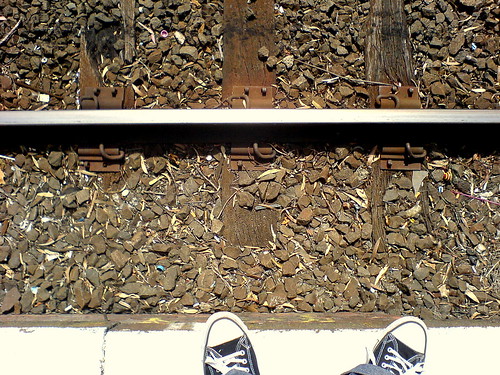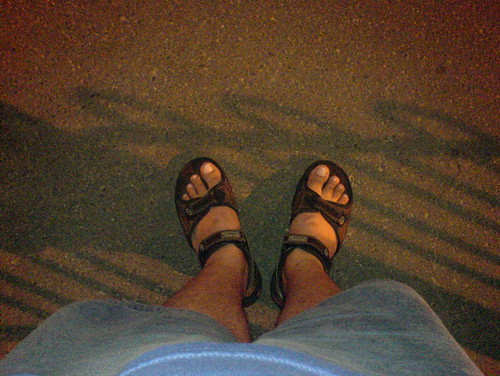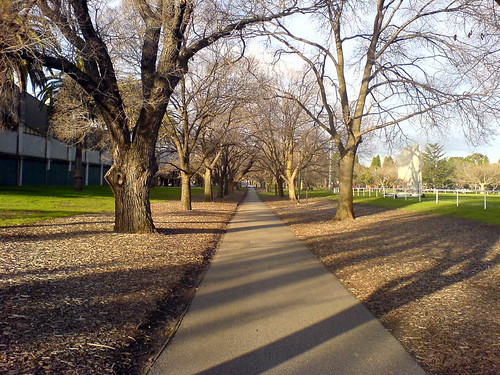I knew from an early age that I was going to be some sort of scientist. Inspired in the mid 80s by
Carl Sagan and his television show
Cosmos – and with both a genuine interest and an aptitude for the field – I went and studied physics and chemistry in both my
O’ and
A’ Levels. Around the same time I was also introduced to computers, starting with the
Apple IIe in 1984 and an
IBM Portable PC soon after. So when it came time to go to
college I basically had to pick an area of science – pure or otherwise – that I wanted to pursue further. In the end, computer sciences won out over my second choice of electronic engineering.
My first foray into
skepticism, meanwhile, came with the advent of the Internet to Pakistan in the mid 90s. I spent countless hours researching and then debunking myths, urban legends, conspiracy theories, phishing scams, and all the other crap that found its way – and still finds its way – into our inboxes. Indeed, during this time, the fast-growing
Urban Legend Reference Pages on snopes.com became one of my favourite and most-quoted websites.
Outside of my life on the Internet, however, I wasn’t skeptical at all: I was religious; I believed in ghosts; I was a proponent of homeopathy and energy healing; I was all for the ‘scientific’ healing techniques of acupuncture, acupressure, and reflexology; and I was quite happy to believe in all the ‘ancient’ treatments, cures, and healing methodologies advocated by ‘experts’ or ‘healers’. I didn’t know back then that ‘experts’ and ‘healers’ meant people who had a vested interest – financial or emotional – in promoting that type of healing.
That said, there were a few things I was skeptical about and these included astrology; transcendental meditation type stuff; pyramid schemes that sold healing pills and devices; and blanket claims like “these are things that large pharmaceutical companies don’t want you to know about” – all of which neither made sense nor were supported by any evidence.
Why Did I Believe in all that Other Crap?I think the main reason I was so gullible was simply because I
wanted to believe. I wanted to believe that there were exciting ideas on the fringe of established and tested science that would one day become real and widely-accepted science if only someone would take the time to investigate them properly. I didn’t know at the time that scientists had done exactly that before rejecting almost all of those ideas as crap.
I was also operating under a very dangerous assumption: I didn’t think I was particularly gullible. In fact, the reason I supported things like homeopathy and Reiki was because I had actually seen them work. What had happened was that, back in the mid 90s, my family was looking after my grandmother who had
Alzheimer’s disease. We were treating her with real medicine but also, as an experiment, with homeopathic medicine.
Now the way
homeopathy works in complex disease situations is that the ‘doctor’ tries out different ‘medicines’ and combinations of medicines till he finds the most suitable combination for treating and, eventually, curing the underlying problem. As a result, the medication keeps changing in order to treat and cure whatever needs to be treated and cured at the time. I understand now the brilliance of this treatment-with-no-end setup but, at the time, all I saw was that my grandmother’s illness varied from week to week and that the doctor gave her different medicines to treat her as she progressed through it. It was
because the manifestation of her disease changed every week that I thought it was the homeopathic medication that had caused that change. I know now, of course, that was a case of false cause or a situation in which I
confused correlation with causation. That is, just because my grandmother’s homeopathic medicines and mental state changed every week, didn’t mean that one was caused –
at all – by the other. Nor did I realize that it was the medicines that were being changed as a result of her existing mental state...and
not the other way round.
My point is that, as far as I knew, homeopathic medicine was science because I could see the treatment working (or not working) in front of my own eyes. In other words, this was a case of
observational selection or
confirmation bias on my part. Further, the doctor was a great authority figure and all the homeopathic medication that we bought was from a large, multinational company – that too, a German one – so naturally I saw it as real, proper, established medical science.
What I didn’t know at that time, however, was what
homeopathy actually was. Had I known that the underlying concepts behind it were water memory, increasing the potency of medication via dilution, and the idea of like-cures-like, I would probably have laughed. Instead, all I saw were medicines that had dosages just like other, real medicines did and so I didn’t even bother to question how it all worked and, importantly, whether it worked at all. [For more, download the
Skeptic’s Guide to Homeopathy pamphlet (88kB PDF file) from the Australian Skeptics]
In other words, I expected a result – as you would of any real medication – and so I saw one. The sad fact is that, thanks to the
confirmation bias that I was operating under, I’m pretty sure I would have seen a ‘result’ regardless of what happened or how my grandmother’s disease progressed over the years that we were looking after her.
This pattern of confusing correlation with causation and seeing results because I expected to see results continued over the next few years. During those years I picked up some new bits of quackery and dropped others. I wasn’t particularly passionate about or really even interested in ‘alternative medicine’ but I did easily accept that there might be something in it and that it might be worth investigating further.
Things ChangeMy ideas about pseudoscience, quackery, woo, and religion all began to change over the last year or so. This happened for a number of reasons that, funnily enough, started with three fantastic courses that I took during my MBA:
Consumer Behaviour was the MBA-equivalent of Carl Sagan’s fantastic book,
The Demon-Haunted World: Science as a Candle in the Dark. It was all about consumer psychology and influence and it taught me about human perception, cognition, and decision-making. In it we covered topics such as
subliminal influence and
Pavlovian conditioning, creating and changing people’s attitudes, how people are influenced (both consciously and unconsciously) by their environment, how culture plays a role in consumer behaviour, and what the ethical concerns around influencing people are. It was awesome.
Brand Management took that a step further and taught me how loyalty to brands, concepts, and ideas works in the real world. I learnt how brands are created, constructed, maintained, and killed and, as promised by our professor, I have never seen brands or the world of marketing the same way since.
Finally, Leadership taught me how to take a long, hard, honest look at myself and it gave me the capacity to analyze and then, assuming I wanted to do so, change what I saw.
Enter the Skeptical MovementAround the time I was taking those courses, I really got into blogging and listening to podcasts. My primary areas of interest were technology and science (including astronomy) so, as you would expect, I eventually came across Phil Plait’s
Bad Astronomy Blog. In June 2008, Plait linked to Brian Dunning’s excellent video on critical thinking called
Here Be Dragons. That video blew me away and I spent the next few weeks listening to all the episodes of Dunning’s brilliant
Skeptoid podcast.
Then, from July onwards, Australia’s Channel 7 broadcast a show called
The One: The Search for Australia’s Most Gifted Psychic (which you can
find on YouTube) and it featured as one of its judges Richard Saunders, Vice President of
Australian Skeptics. With all that I’d learnt during my MBA and my interest in film and television – because of which I know how TV shows are made, edited, and marketed – I had a pretty good idea of what was going behind the scenes in this show. So when, despite all the show’s obvious biases, the psychics proved themselves to be incredibly poor performers under even minimally reasonable scientific conditions things started to fall into place a little quicker than they had before. (There’s nothing like the power of television, huh? Funnily enough, I doubt the producers of
The One expected it to have a de-converting effect on even one of its viewers!)
After some basic research into
logical fallacies and
cognitive biases – with Skeptoid episodes
73 and
74 as my starting point – I spent the next couple of months going over my entire life and analyzing everything I’d ever believed in, assumed to be trued, presumed to be true, or simply not thought about all that much. I remember having discussions with my wife during which I would try to come up with non-pseudoscientific explanations for whatever had been happening and finding that, as expected, the pseudoscientific explanation seemed incredibly unlikely and, in most cases, quite silly. Oh, and there were many, many more cases in which I had confused correlation and causation.
I also started listening to two awesome podcasts: the New England Skeptical Society’s
Skeptics Guide to the Universe (SGU) and the Australian Skeptic’s
The Skeptic Zone. Meanwhile, I started subscribing to
The Skeptic magazine and, as suggested in
Here be Dragons, bought and read Sagan’s
Demon-Haunted World. I also read and
watched all I could about
James Randi – who I’d always known about but had never really looked into – and the
James Randi Education Foundation. All this research was, of course, supplemented by reading lots of skeptical blogs (there will be a whole list of them in a subsequent blog post).
With all that going on in my life and in my head, it wasn’t long before the deal was sealed and I could safely say that I was a proper Skeptic (complete with a capital ‘S’ and the letter ‘k’).
Since then I have started to see the world through a completely different filter – a clear one this time – and boy is there a lot
of crap out there. Just knowing a handful of logical fallacies, for example, has helped me unravel stupid arguments, see through cheap tricks (particularly marketing-related ones), and call people out when they’ve needed to be called out (
even in unrelated situations).
I’ve also started to learn a lot more about science, skepticism, argumentation techniques, cognitive biases, and all the other things that help perpetuate and sustain quackery and pseudoscience throughout the world and across the generations.
Overall, my life has changed dramatically and the world now makes much more sense. I am also much happier and much more settled than I have ever been before.
So What Next?Where I’ll go from here, I’m not sure. I know I have a lot more learning to do and, in the near term, I intend to attend the next
Skeptics Cafe with the
Victorian Skeptics. I’m also going through the list of things in the book
What Do I Do Next: 105 Ways to Promote Skeptical Activism (edited by Daniel Loxton) to see where that can lead.
I have started to talk to other people about skepticism and why it makes so much sense but that’s going slowly. I’ll ramp it up once I’m more confident about my abilities to counter pseudoscience in real time as opposed to via e-mail and after a round of detailed Internet-based research!
In the meantime, I’ll start being much more skeptically active on my blog. (I’ve even created a new category called ‘Skepticism’ for doing just that.) The first step in that direction was writing this blog post. The next step will be listing a whole bunch of skeptical resources that are really useful regardless of whether you’re already into skepticism or are just starting down that path. I might go ahead and make that into a separate page on my blog as well.
Whatever happens, though, I’ll keep you updated.







